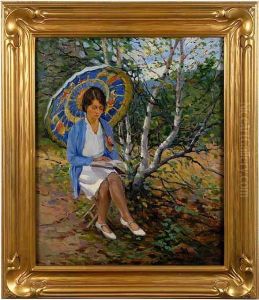Florence Wilkins Furst Paintings
Florence Wilkins Furst was an American artist born in 1878, whose contributions to the art world, particularly in painting and printmaking, have been noted for their distinct style and emphasis on American themes. Furst's career spanned a dynamic period in American art, bridging the transition from the late 19th century into the modern era of the early 20th century. Despite facing the challenges of being a woman in a predominantly male-dominated field, she managed to carve a niche for herself and gain recognition for her artistic talents.
Furst's early life was marked by a keen interest in the arts, a passion that was supported by her family. She pursued formal education in art, which was a significant step for women at the time, who were often discouraged from professional careers. Her studies took her to prestigious institutions, where she honed her skills and developed a style that was both reflective of her personal vision and the evolving trends in American art.
Throughout her career, Florence Wilkins Furst exhibited a versatility in medium and subject matter, from landscapes and portraits to more abstract compositions. Her work was exhibited in various galleries and earned her memberships in esteemed art societies, reflecting her growing influence in the art community. Despite this, like many women artists of her era, Furst struggled to receive the same level of recognition as her male counterparts.
Furst was not only a talented artist but also a dedicated advocate for the arts. She was involved in several initiatives aimed at promoting art education and supporting emerging artists, especially women. Her efforts contributed to the gradual opening of doors for future generations of women in the arts.
Florence Wilkins Furst passed away in 1953, leaving behind a legacy that, while perhaps not as widely recognized as some of her peers, is cherished for its contribution to the richness and diversity of American art. Her life and work continue to be studied by art historians and enthusiasts, who see her as a pivotal figure in the transition towards modern American art and a trailblazer for women in the arts.
